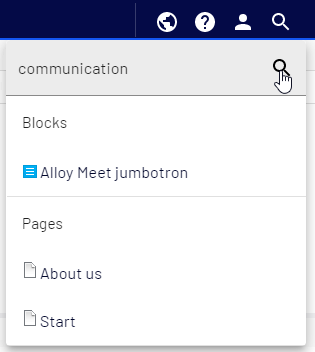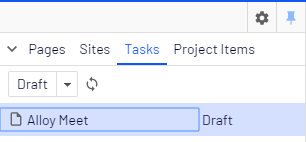FAQs
This topic provides answers to the most frequently asked questions by Optimizely users.
CMS for editors
Content editing
In the Optimizely navigation pane, there are a number of icons relating to the page status. Note that some of these status icons are only displayed for the first draft version where no published version exists (this is to avoid cluttering the user interface with too many icons).
| The root page. | |
| Start page. | |
| Published page. See Working with versions. | |
 | Page that links to another page on the same website. See Shortcut to page in Optimizely CMS under Shortcut in Working in All properties editing view. |
 | Page that links to an external website or a specific address. See Shortcut to page on another website under Shortcut in Working in All properties editing view. |
 | Page containing a shortcut that is not linked anywhere; it only displays the text and is used to create a heading with no link in the menu. See No shortcut, display text only under Shortcut in Working in All properties editing view. |
 | Page that fetches and displays content from another page on the same website. See Fetch content from page in Optimizely CMS under Shortcut in Working in All properties editing view. |
| Container page used for storing other pages; not visible on the website. | |
| Draft of a new page; not visible on the website yet. See Working with versions. | |
| New page scheduled for publishing; not visible on the website yet. See Working with versions. | |
| Expired page; not visible on the website anymore. See Working with versions. | |
| Page that is set to Ready to Publish. See Working with versions. | |
| Page that is set to Rejected. See Working with versions. | |
| Page is currently In review and must be reviewed and approved before it can be published. See Content approvals. | |
| Previously published page; not visible on the website anymore. See Working with versions. | |
| Page locked for editing for the logged-in user. | |
| Page being edited by another user. You can see who by hovering your mouse over the icon. | |
| Published page. Note: This icon appears for project items; not in the Pages navigation pane. See The projects feature. | |
| You do not have the rights to publish this item or the specific item version does not exist anymore. Note: This icon appears for project items; not in the Pages navigation pane. See The projects feature. |
Content items can have the following status in the Versions gadget:
- Draft. Content that is work-in-progress and is not yet subject to any publishing actions. There can be multiple drafts.
- In Review. The version is set to Ready for Review and must be approved before it can be published. See Content approvals.
- Published. The most recently published version and the one publicly displayed. Only one published version can exist.
- Previously Published. One or more versions that were published before the latest published version.
- Ready to Publish. Content has gone through a content approval sequence and was approved for publishing, or it was manually set to Ready to Publish. Withdraw and Edit from the Options/Publish menu sets the content to an editable draft again.
- Rejected. A draft that was declined by someone as part of an content approval sequence, or manually after it is set to Ready to Publish. You can edit and update declined content and then set to Ready for Review or Ready to Publish again.
- Scheduled for Publish. Content scheduled to be published at a later time.
- Expired. Content where a stop publish date and time were set and passed.
See also Working with versions.
- From edit view A section of the user interface where you edit content items, such as pages and blocks. To access edit view, log in and select CMS > Edit. (See admin view for comparison.), click Tasks in the navigation pane.
- Use the drop-down list to select the status of interest.
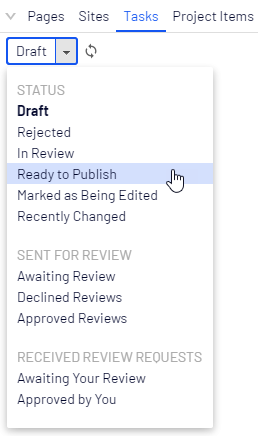
No, you can safely click this option. No previous edits are lost.
Click Preview  to access preview mode. From there, you can click links and verify that they are accurate.
to access preview mode. From there, you can click links and verify that they are accurate.
- Select Undo in the page information area to discard changes made since the last autosave.
You can undo changes made only in the current editing session. If you move to another page, close the browser, log out, and so on, the history of actions that can be undone is emptied.
- If content was previously published, select Revert to Published from the Publish? button to return the last published version.
- In edit view A section of the user interface where you edit content items, such as pages and blocks. To access edit view, log in and select CMS > Edit. (See admin view for comparison.), open the content item that has different versions you want to compare.
- From the toolbar, click the Compare button
 . Select the On-page compare mode, if not already selected.
. Select the On-page compare mode, if not already selected. 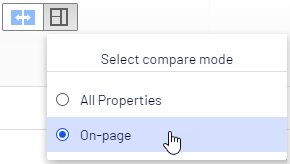
The current version appears on the left.
- From the Comparing bar, click the Previously published drop-down list. Previous versions appear.
A system administrator configures the number of versions that your site maintains. The default value is 20.
- Select the version that you want to compare with the current one.
- When you are done, click the Compare button again to return to the edit view.
Add the Recent gadget to your left or right pane. The Recent gadget displays content viewed during your current session. See also: Managing gadgets.
Click the Full Screen button.

Click the same button again when you want to close the full screen.
Content publishing
If you add an image to a page in edit view but it is not displayed when the page is published, it is most likely because the image itself is not published. Media (such as images and files), blocks and forms need to be published just as pages do. Publish the image and it will be displayed on the website.
Avoid this with the following solutions:
- An administrator can enable the Auto publish media on upload feature. This automatically publishes images and files when you upload them. However, media is not auto published, even if this option is selected, if the folder you are uploading to has a content approval sequence set.
Even though the media is not publicly available on your website until it is included in a published page, it is indexed immediately and can be found through a search. This is worth remembering if you are uploading sensitive information that should not be accessible until a set time, such as an annual report.
- Use the projects feature. When you are working in a project and add images, blocks or forms to a page, these are automatically added to the project. From the project overview you can set all items (including media, blocks and forms) to Ready to publish and publish them at the same time. If the projects feature is enabled, media is not auto-published, even if the Auto publish media on upload setting is enabled.
Add the Versions gadget to your left or right pane. From this gadget, you can view and republish older versions. See also: Managing gadgets.
The projects feature automatically associates pages, assets, blocks, catalog items and so on while they are under development. When ready, use the project overview to simultaneously publish all items with a status of Ready to Publish.
If the projects feature has not enabled on your website, you can use the projects gadget instead to multi-publish items.
Miscellaneous
- From the navigation or assets pane, select Settings > View Trash.
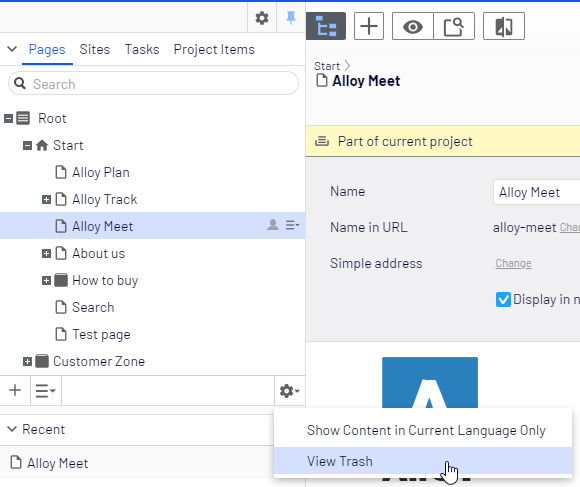
- Select the content to restore.
- Click Restore.
The content is restored to its original place. If it was published, it is republished.
- In the upper right corner, click your user name.
- Select the Display Options tab.
- From the Personal Language drop-down list, select the language of your choice, and click Save.
Use the Versions gadget to work with multiple drafts. The gadget also lets you label any draft the primary draft. When opening an item, Optimizely CMS displays the version that is set as primary, or, if a project is active, the version associated with the active project. See also Versioning when working in projects.
Drag and drop is available in many instances.
- While editing a page in the rich text editor, create a link by dragging a page from the page tree.
- Drag and drop images into the editor.
- In the assets pane, drag and drop assets between folders.
- In the page tree, drag and drop pages to change the order.
Go to the top menu > CMS > Reports. See Reports for a list of standard Optimizely reports.
When creating or editing the page, click All properties  . Then, clear the Display in navigation check box.
. Then, clear the Display in navigation check box.
- From the dashboard, navigation pane or assets pane, select Settings > Rearrange Gadgets.
- Drag and drop a gadget to the desired position.
There are two ways to enable Optimizely projects functionality.
- Your administrator enables the projects feature for the entire site. In this case, you see a project bar at the bottom of the CMS window. If you create a project from that project bar and have it selected, content is automatically associated with the project when you create or edit it. The specific content version is associated with the project for all users, so other users must use that project to update that version or create a draft from it.
Use these tips to find content from the CMS edit view A section of the user interface where you edit content items, such as pages and blocks. To access edit view, log in and select CMS > Edit. (See admin view for comparison.).
| What you know | Action |
|---|---|
| Content location within page, asset or block structure | Navigate the page tree structure or the blocks and media assets pane and select content. |
| Content location on the website | Using the preview option, go to the content on the website. |
| Content is associated with a project | Use the projects gadget or, if you are using the projects feature, the project overview or the project items navigation pane. |
| Text within content title or body |
Use the global search in the top menu, or the search fields at the top of the navigation and assets panes.
See Search for search tips. Image: Navigation and assets panes
Image: Global search
|
| A page's status (for example, draft) | Use the Tasks tab in the navigation pane to find content in that status.
The statuses Draft and Rejected show items that you, as the logged-in user, have created or modified, while other statuses, such as In Review and Recently Changed, display all matching items on the website, regardless of who updated them. For a complete description on what the statuses display in the Tasks tab, see Use the Tasks tab. |
| Content was edited recently | Use the Recently changed status in the Tasks pane. |
Prerequisite: The desired language is activated and enabled in edit view A section of the user interface where you edit content items, such as pages and blocks. To access edit view, log in and select CMS > Edit. (See admin view for comparison.). See Managing website languages.
When translating an existing content item or block, click Compare. See Comparing language versions when translating content
When translating a website, the Optimizely Languages add-on is helpful.
- Activate the project in the project bar, if not already done.
- Select the content that you want to preview.
- Click Preview. You can now navigate your site and see what it would look like if items in the project were published. That is, previewing when a project is active shows you the draft associated with the project or, if there is no draft associated with the project, the published version.
A landing page is an important tool for generating leads and converting visitors. The following tips can help you make the most of it:
- Landing page visitors who are redirected from an ad or a search should see content that matches their expectations. For example, if an ad promotes a 10% discount, the landing page should give the same message.
- Keep it simple and do not forget to use white space. A cluttered landing page scares people off.
- Create engaging copy. Who are your visitors or customers? Adjust your language and tone to your target group.
- If you want visitors to perform an action (sign up for a newsletter, enter a competition, buy an item), make sure that a form, block, or teaser is the focus.
- Keep forms short. For the Submit button, use a phrase that is more engaging than Submit such as Buy now! or Visit our travel site!.
- Test your landing page. Make sure it functions as well on a mobile device as on a larger screen.
- Include links to your company's social media pages.
CMS for administrator
Prerequisite: Assumes that the users already exist, and belong to the WebEditors group and a group that gives them access rights to content being created/edited.
- Go to admin view Where administrators manage access rights, website languages, scheduled jobs, export and import of data between websites, and configure new websites in a multi-site solution. (See edit view for comparison.) > Admin tab > Access Rights > Administer Groups > Add.
- Create a new group called German editors.
- Under Access Rights, click Search User/Group.
- Select a user.
- On the Edit User screen, assign the users to the German editors group.
- Repeat steps 3-5 for all German editors.
- From the Admin tab, go to Config > Manage Website Languages.
- Select German (Deutsch).
- Click Add Users/Groups. The Add Users/Groups dialog box appears.
- From the Type drop-down list, select Groups and click Search.
- Select the German editors group. Then, click the right arrow to move it to the Add area.
Click OK.
All users belonging to the German editors group now have access to German content.
The user needs membership in a structure-based group that has Change access rights.
Each group can have different access levels, for example create and change, or create, change, and publish, and so on. Make sure the user belongs to a group that has Create and Change access rights for the page.
Optimizely comes with a content approval feature that gives you exactly this functionality. As an administrator, you can define which content must go through the review and approval procedure, and also define who should review and approve each content item. Read more on how to set up this procedure in Managing approval sequences.
To enable the creation of content in multiple languages, you need to complete two steps. If you see this error, you completed step 1 but not step 2 for a page in the following procedure.
- Enable a language on the website.
- Enable a language for editing in CMS. See Enabling a language for editing in CMS in Managing website languages.
Optimizely's personalization features let you optimize each visitor's experience by customizing web pages for different users and groups. Customization is based on factors such as geographic location, language, previous visits, day or time of visit.
Optimizely is installed via a number of NuGet packages and if you have access to the website's code base, you can check the version number of the NuGet packages. You can also see the version numbers of the installed components in the admin view > Config > Tool Settings > Plug-in Manager.
Optimizely Commerce
- A product package Commerce: a sellable unit that contains variants and/or other packages, with a single price; similar to an SKU because it must be purchased as a whole (such as a computer system). contains multiple products or variants Commerce: a variant or SKU corresponds to a specific product with specific characteristics. For example, a product line of shirts has individual variations/SKUs that include size, color, and collar size., and has one price.
- A product bundle Commerce: a collection of packages, products, and variants (SKUs) that let customers purchase two or more items at once. Each item in a bundle is a separate line item in a shopping cart. is a collection of variants with individual pricing. Customers can purchase two or more items at once.
The team developing Optimizely Commerce blogs about new features and best practices and so on on the community site Optimizely World.
- Create a user profile on Optimizely World by clicking Register in the top right corner.
- Go to the developer forum for Commerce and click New Topic.
Catalogs Commerce: a top-level container for catalog entries such as categories, products, and variants (SKUs)., markets One or more countries, regions or customer groups, to which you want to apply languages, catalogs, currencies or promotions. The market features support targeted merchandising and personalization., and payment Commerce: the verification of a money transaction in a website shopping situation. The e-commerce system most often needs a verification for a payment to create the actual purchase order and complete the shopping workflow. and shipping Commerce: A set of information and rules that determine the shipping cost. Displayed on the front-end public site while a customer checks out an item from the shopping cart. The shipping fee is added to the total price of the purchase. A shipping method is mapped to a shipping provider visible to a back-end administrator in Commerce Manager. For example, when a customer picks "Ground Shipping," UPS (or another provider) may fulfill the shipment. methods.
Both promotions Commerce: A way to apply a discount to products, order totals, or shipping; a marketing tool used to increase sales of certain products or product lines. A promotion is associated with a campaign. In recent Commerce versions, this term is replaced by "discount." should apply as long as these conditions are met:
- The promotions are not excluded by each other or by other promotions.
- The conditions for the second promotion (lower priority) are satisfied after the first promotion is applied. For example, the first promotion discounts the cart $50, making the cart subtotal $480. If the second promotion requires the cart subtotal to be at least $500, it is no longer satisfied.
See this forum post on Optimizely World: Best practice catalog design and product/variant options.
Campaign
A DOI A practice in which a recipient consents to receiving email from the sender before any promotional email is sent. Recipients receive an email with a double opt-in link, which they must click to confirm their interest. link is valid for 30-36 days, unless there is a shorter time configured in the client The working environment of Optimizely Campaign. A client is a stand-alone and closed system that serves to organize your mailings. Campaign users can use one or more clients for your scenario.. If the recipient does not confirm the link within this time, this is considered as a rejection and all temporary data will be deleted. The deletion usually takes place on weekends (hence the 30-36 days).
Yes. Customer support permanently saves the website address to which recipients will be forwarded after clicking the confirmation link. Therefore, inform customer support if the URL changes.
When a DOI process is created, the system automatically creates an empty confirmation mailing that is firmly linked to the process. To use a template other than the free text template, remove the existing message node in the campaign editor. Drag and drop a new message node (type: Email) onto it and select an existing template in your client. When editing:
- Use the field function {Double Opt-in Link} to link to the confirmation page. The field function is converted into an URL when the mailing is sent and is valid only once and only for the specific recipient.
- The DOI process itself does not assign a recipient to a recipient list. When a recipient is transmitted, the DOI process and the recipient lists are selected separately (for an CSV import by selecting a recipient list, for the HTTP-API Stands for "application programming interface". The API specifies how some software components should interact with each other, such as accessing a database or computer hardware, or easing the work of programming graphical user interface components. APIs often are in the form of a library that includes specifications for routines, data structures, object classes, and variables. See also: https://world.optimizely.com/documentation/class-libraries/ via the authorization code and for the SOAP-API via the recipient list ID). For example, you can address 20 lists with one DOI process, or only one list with 20 DOI processes.
- For technical reasons, the test list of the client is assigned to the DOI mailing. Do not change this assignment.
For more information on double opt-in, see Opt-in and Deliverability.
- It is recommended to use Optimizely Campaign's unsubscribe link by using the field function {Unsubscribe Link}.
- You can also use other unsubscribe logics such as linking to a web page that processes the unsubscription and transmits it via API (if the unsubscribe was done by one-click unsubscribe).
- In addition, all mailings contain a so-called list unsubscribe header. The list unsubscribe header is a functional (invisible) part of the mailing that displays an additional unsubscribe option in some email clients.
- The Certified Sender Alliance (CSA), which ensures deliverability for many large providers, regards the use of this service as binding.
- Unsubscriptions generated via the list unsubscribe header are collected in the regular unsubscribe list, ensuring that these email addresses are no longer addressed to.
- A recipient with a lower attention span will tend to click the list unsubscribe header rather than the spam button. This has a positive effect on the reputation of your mailing domain, as this generates a "normal" unsubscription.
For more information on unsubscribes, see Unsubscribers and Deliverability.
No recipient will be automatically removed from the recipient list, even if they cannot be addressed permanently or temporarily. During dispatch, the system automatically checks whether a recipient is on one of the lists that may exclude the recipient from the sending. These lists are:
- Unsubscribe list. After unsubscription (using Optimizely Campaign's unsubscribe options), the recipient is added to the unsubscribe list. This applies globally in the client and does not affect only a specific recipient list. If a recipient goes through a DOI process again, this unsubscription is reversed.
- Blocklist. If a recipient is on the blocklist, no further mailing will be sent to him, which also includes DOI mailings. Blocklist entries are inherited by sub-clients and can only be removed manually.
- List of the recipients that exceeded the bounce limit. A threshold value for hard and soft bounces is configured in each client. If a recipient reaches this threshold value, he or she is entered in this list. Entries here can only be removed manually by customer support.
Field functions are placeholders in mailings that generate content when the mailing is sent. They are displayed in curly brackets { }. There are four different types of field functions:
- System field functions. Field functions such as {Unsubscribe Link}, {Double Opt-in Link}, {Online-Version-Link}, {bmMailId}. These field functions are associated with system functions and are the same in each client and in every language.
The names of the field functions defer according to the language settings in your client.
- Salutation logic. A salutation logic queries whether content is available in certain recipient list fields (for example in Salutation and Lastname) and whether certain criteria are met (for example: Salutation = Mr. or Mrs.). If there is no content available or the content does not meet the criteria, a fallback takes effect. Example: If the Salutation is Woman and Lastname is Miller, the salutation in the mailing could be Dear Mrs. Miller. If there is no salutation available, the fallback takes effect and the email starts with Dear Ladies and Gentlemen.
- Recipient list fields. Each recipient list field can be inserted as a field function using {name of the field} in mailings. The content will be output as it is, even if the field is empty. If date fields (with the data type Date) are to be output,Optimizely Campaign outputs the date as a timestamp in the format yyyy-mm-dd hh:mm:ss in the recipient list . For a different output, a special field function must be created that rewrites the timestamp into the desired format.
- Special field functions. Special field functions include query logics and outputs that can be very complex and go beyond simple queries like a salutation logic. Depending on their scope and complexity, this is carried out by technical customer support or a web developer and may need to be ordered separately.
For more information on field functions, see Field functions.
Yes. Note that recipients are always calculated at the actual send time of each split mailing. The number of recipients can differ from the calculation prior to the mailing dispatch.
- Example 1. Filtering a target group by actions over a period of time
If you use the Target groups node to filter recipients by one or more actions over a period of time (for example, opens within the last 7 days), the number of recipients can change after the first split mailing. Since the recipient list is recalculated for the next, later split mailing, unexpected numbers of recipients may occur.
- Example 2. Using more than one target group filter
If you receive a recipient list with, for example, 20000 recipients by using the Target groups node and configure the first split mailing with 10%, the mailing is sent to 2000 recipients. If you also set a target group filter for this split mailing that calculates 2500 recipients, only 2000 recipients receive the mailing. If you configure the next, later split mailing with the same target group filter, only the remaining 500 recipients receive the mailing.
In Mailings Classic, if a master mailing with one or more split mailings is selected, this filter matches the recipients of the master mailing plus the recipients of associated split mailings. If a split mailing is selected, only recipients of this split will match. Be aware that this behavior leads to unusable results if a master mailing and an associated split mailing are combined in a filter rule because recipients would be counted twice. To create a filter that matches only the recipients of the master mailing, create the target group as follows: has received master mailing AND has NOT received split mailings 1,2,...

